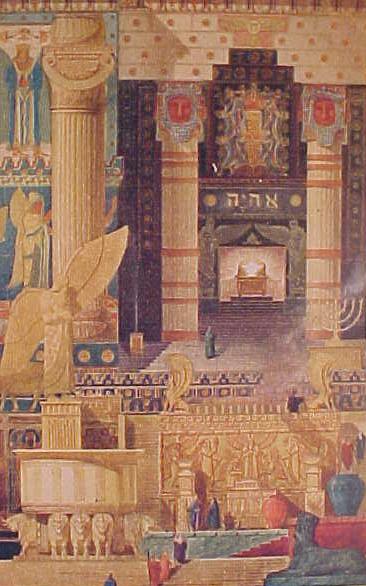Wednesday, July 23

Iconography in Solomon's Temple according to Helme and Corbett's Reconstruction
Towards an Incarnational Architecture, Part III:
The Goodness of Creation: Solomon's Temple and the Nature of Nature
I was amazed and humbled by the beauty and depth of the responses to the latest installment of Towards an Incarnational Architecture. In fact, I didn't expect I had anything else to write, but you surprised me, and I surprised myself. In many ways, your comments tied together my various thoughts in the first and second parts. In particular, I was struck by the notion of the redeemed holiness of creation as well as of the body.
Incarnational architecture images both Man, whose body is the summit of creation, and Creation itself, which is, in its totality, "very good," as Genesis tells us. "For goodness, which in God is simple and uniform, in creatures is manifold and divided; and hence the whole universe together participates [in] the divine goodness more perfectly, and represents it better than any single creature" (Summa, I.xlvii.1). He says also: “for the universe would not perfect if only one grade of goodness were found in things (Summa, I.xlvii.2) spoke of my fondness for the Dominican spirit, and perhaps seemed more surprised than I should have when I found my mind turning to il Poverello, but here we can see the gaunt, bony Seraph of Assisi embrace the solid, stony Doctor Angelicus.
At present, I am working on a watercolor painting of Solomon's Temple, actually. Elizabeth's excited comment, citing Exodus xv, "Let's have temples that are microcosms of the entire creation. God wants it this way […] beauty, symbols! Pomegranates, trees, flowering staffs, gold, purple, precious gems," comes with great resonance for me. Through a misreading of the Decalogue and the sorts of images one finds in Protestant Bibles, we tend to think the Israelites used no images whatsoever in their worship of God, as if they were Semitic Puritains. You couldn't be more far from the truth, as Elizabeth reminded me. Most reconstructions of the Temple (or even the earlier Tent of the Presence from Exodus, which Elizabeth was talking about) support the fact that Solomon's Temple, the perfect archetype of a Church in its God-given measurements, also bore a complex iconography painted on its walls and sculpted in its shape that took in the different goods of Creation.
While God was not depicted in human form (for God did not yet have a human face), the Temple, to all accounts, was as splendidly decorated as a Babylonian ziggurat. Its walls bore scarlet tile-work angels against indigo backgrounds, winged lions and winged bulls, vegetal patterns, palm trees, colorful abstract designs, and huge seraphim in gilded wood and bronze, standing guard over the Holy of Holies within and the great gatehouse without. One reconstruction even has the swirling glory-cloud of God, what the Hebrews called the Shekhinah (identified by some as the Holy Spirit) painted over the great portal.
So we can see it is appropriate that the great architects of history have often sat at the feet of Nature and studied her. Nature is solemn, but nature is also joyous: "a little, dancing sister," as Chesterton called her in his biography of St. Francis. What we learn in her God-given forms covers the gamut of human emotion. Thus, a solemn Classical temple, with its echoes of Alberti's mythic Primitive Hut, or a joyful rococo church with its seaweed sweeps of rocaille and asymmetrical plasterwork, or the splendid temple of Solomon, or its desert Tabernacle predecessor with its pomegranates and cherubim, can draw their different and various inspiration from creation.
Coming soon...
Part IV: Architecture and the Redemption of Creation and Part V: The Communio Personalis of the Trinity and Architecture (thanks, Nicole!)












